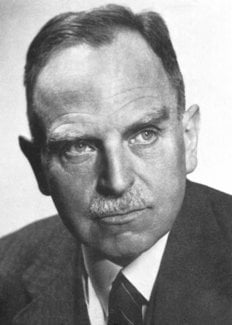Otto Hahn
Biographical

Otto Hahn was born on 8th March, 1879, at Frankfurt-on-Main. He attended the secondary high school there until he matriculated.
From 1897 Hahn studied chemistry at Marburg and Munich, taking his doctorate examination in 1901 at Marburg and submitting to Professor Theodor Zincke a thesis on organic chemistry.
He obtained a post as assistant in the Chemical Institute at Marburg, staying there two years, after which he worked under Sir William Ramsay at University College, London, from the autumn of 1904 to the following summer. His work here was rewarded by the discovery of a new radioactive substance, radiothorium, while working on the preparation of pure radium salts.
From the autumn of 1905 to the summer of the following year Hahn was at the Physical Institute of McGill University, Montreal (Canada) working under Professor Ernest Rutherford. Here he discovered radioactinium and conducted investigations with Rutherford on alpha-rays of radiothorium and radioactinium.
On his return to Europe Hahn moved to Berlin, to the Chemical Institute (Emil Fischer) of the University and there he qualified as a university lecturer in the spring of 1907, which year also saw his discovery of mesothorium.
At the end of 1907, Dr. Lise Meitner came to Berlin from Vienna and then began more than thirty years’ collaboration. Their joint work embraced: investigations on beta-rays, their absorbability, magnetic spectra, etc.; use of the radioactive recoil, discovered shortly before by Hahn, to obtain new radioactive transformation products.
Between 1914 and 1918 Hahn’s work was interrupted by his service in the First World War, but he resumed his research with Professor Meitner in 1918, and discovered protactinium, the long-lived mother substance of the actinium series. Hahn’s own particular sphere was chemistry and he further discovered uranium Z, the first case of a nuclear isomerism of radioactive kinds of atoms. Using radioactive methods he investigated the absorption and precipitation of the smallest quantities of substances, normal and abnormal formation of crystals, etc. Hahn used the emanation method to test substances superficially rich or poor, and he elaborated the strontium method to determine the age of geological periods.
Following the discovery of artificial radioactivity by M and Mme. Joliot-Curie and the use of neutrons by Fermi for atomic nuclear processes, Hahn again collaborated with Professor Meitner and afterwards with Dr. Strassmann on the processes of irradiating uranium and thorium with neutrons.
Hahn and Prof. Meitner had also worked together on the discovery of an artificially active uranium isotope, which represents the basic substance of the elements neptunium and plutonium, first revealed later in America.
Hahn’s work has won recognition in many learned circles. In 1912 he became scientific member of the Kaiser Wilhelm Institute for Chemistry and has been Director of this Institute since 1928. 1933 saw his appointment as Visiting Professor at Cornell University, Ithaca, New York. From 1st April, 1946, he has officiated as President of the Kaiser Wilhelm Society and from 28th February, 1948, has served as President of the Max Planck Society in Western Germany, being created Honorary President of the same Society in May, 1960.
His most spectacular discovery came at the end of 1938. While working jointly with Dr. Strassmann, Hahn discovered the fission of uranium and thorium in medium heavy atomic nuclei and his first work on these subjects appeared on 6th January and 10th February, 1939, in Naturwissenschaften. Since that time and until 1944 Hahn continued investigation on the proof and separation of many elements and kinds of atoms which arise through fission.
Hahn has been granted membership of the Academies of Berlin, Göttingen, Munich, Halle, Stockholm, Vienna, Boston, Madrid, Helsinki, Lisbon, Mainz, Rome (Vatican), Allahabad, Copenhagen, and the Indian Academy of Sciences.
In 1913 Hahn married Edith, née Junghans and they had one son, Hanno, born in 1922, killed by accident in 1960.
This autobiography/biography was written at the time of the award and first published in the book series Les Prix Nobel. It was later edited and republished in Nobel Lectures. To cite this document, always state the source as shown above.
For more updated biographical information, see: Hahn, Otto, My Life. Macdonald & Co, London, 1970.
Otto Hahn died on July 28, 1968.
Nobel Prizes and laureates
Six prizes were awarded for achievements that have conferred the greatest benefit to humankind. The 14 laureates' work and discoveries range from quantum tunnelling to promoting democratic rights.
See them all presented here.
